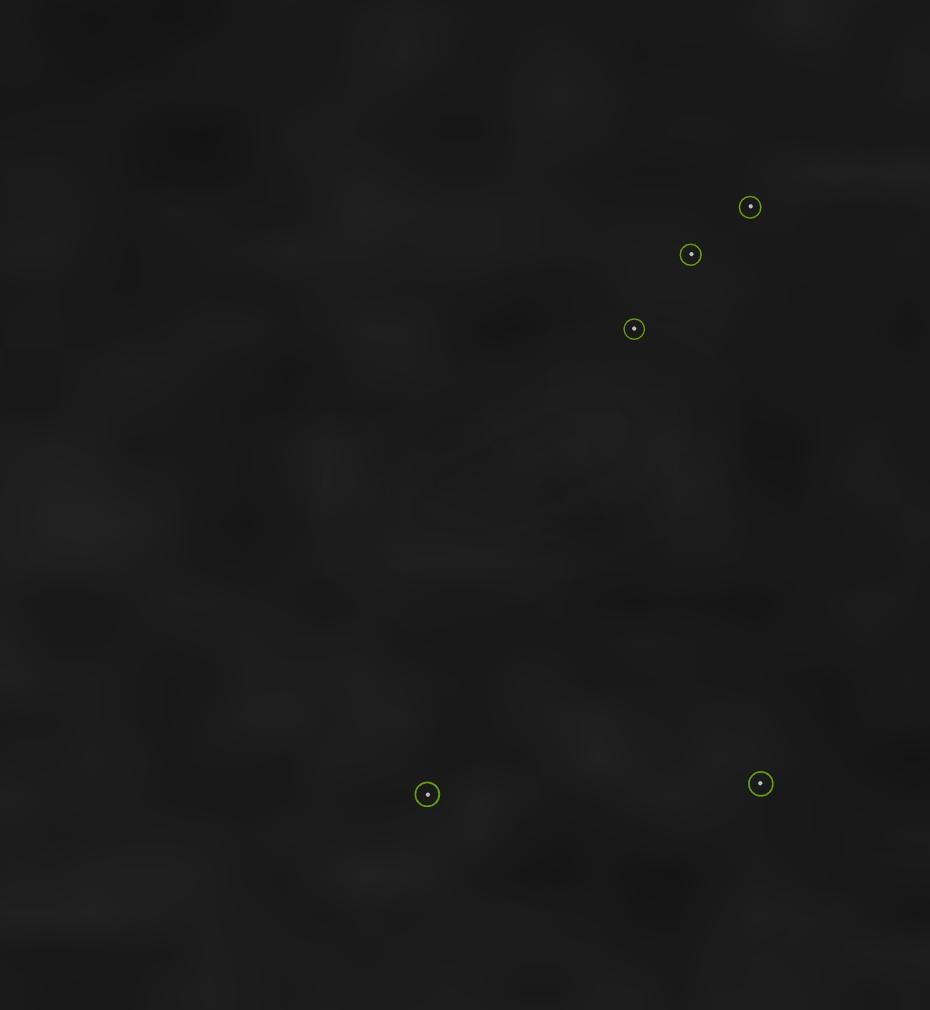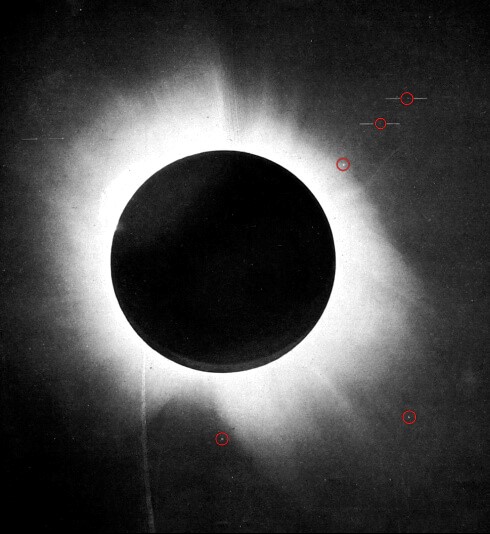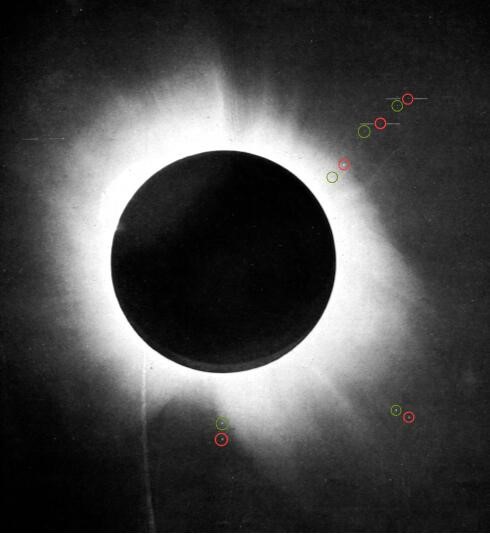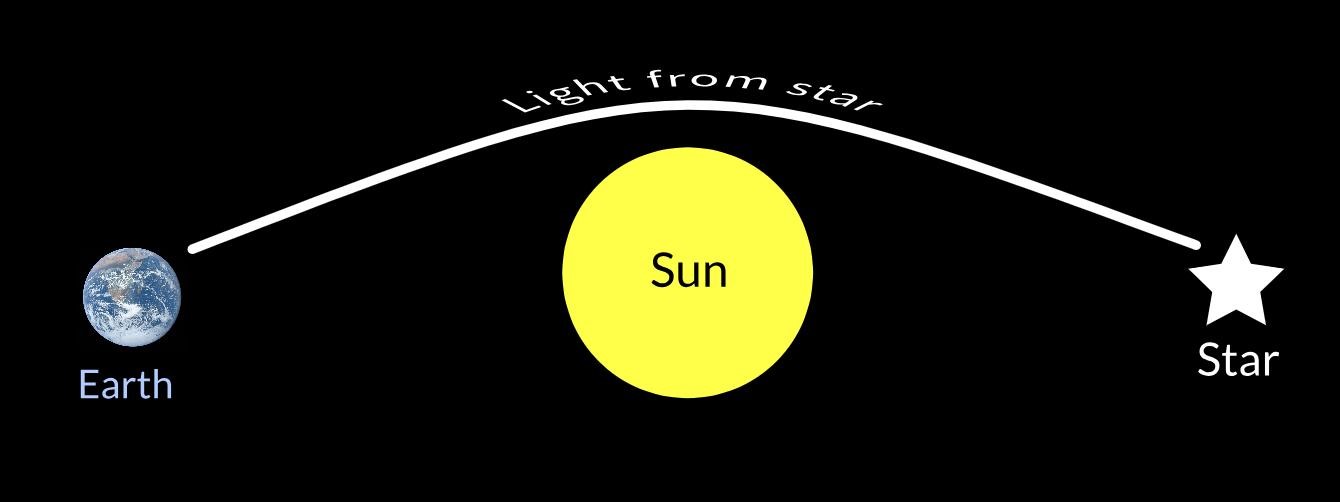1919 eclipse verifies Einstein's theory



General relativity, proposed by Albert Einstein, predicts that the path of light bends when passing near a massive body. Although the deflection of light near massive bodies could be guessed at using Newtonian mechanics1, Einstein’s theory demanded it. Einstein made his prediction in November 19152 after modifying an initial 1911 prediction3 of his own, upon obtaining the 1915 equation discovered by Karl Schwarzschild for the gravitational field around a spherical body:

The image below depicts the light from a distant star bending around the sun and reaching the earth.

Einstein's prediction was put to the test by physicists Frank Dyson and Arthur Eddington during a total solar eclipse of May 29, 1919. The eclipse, by blocking the sun's light, made visible the light from stars in an especially bright star cluster behind the sun, the Hyades star cluster, which these physicists and their teams photographed during this eclipse, shown in the plate given in Figure 2 above. They compared this to the position of the stars without the eclipse, digitally replicated5 in Figure 1. Overlaying the two plates shows the change in position of the starlight, which the physicists found to closely match Einstein's prediction.6
By: Anthony Coniglio, Anthony Rizzi
Links used in the writing of this document:
- https://en.wikipedia.org/wiki/Eddington_experiment
- https://en.wikipedia.org/wiki/Gravitational_lens#History
- https://en.wikipedia.org/wiki/Schwarzschild_metric
- https://en.wikipedia.org/wiki/Johann_Georg_von_Soldner
- https://en.wikipedia.org/wiki/History_of_general_relativity
- https://en.wikipedia.org/wiki/Hyades_(star_cluster)
- https://en.wikipedia.org/wiki/Tests_of_general_relativity#Deflection_of_light_by_the_Sun
- https://en.wikipedia.org/wiki/List_of_scientific_publications_by_Albert_Einstein
2. Einstein put forth a series of 4 papers on his general relativity in November 1915, to the Prussian Academy of Sciences: Grundgedanken der allgemeinen Relativitätstheorie und Anwendung dieser Theorie in der Astronomie (Fundamental Ideas of the General Theory of Relativity and the Application of this Theory in Astronomy); Zur allgemeinen Relativitätstheorie (On the General Theory of Relativity); Erklärung der Perihelbewegung des Merkur aus der allgemeinen Relativitätstheorie (Explanation of the Perihelion Motion of Mercury from the General Theory of Relativity); Feldgleichungen der Gravitation (The Field Equations of Gravitation). 3. Einstein, A. (1911). "On the Influence of Gravitation on the Propagation of Light". Annalen der Physik. 35 (10): 898–908.
4. Credits for the photograph of the earth within this diagram are NASA/Apollo 17 crew, taken by either Harrison Schmitt or Ron Evans on December 7, 1972.
5. The following link is the digital drawing program used to create Figure 1 based on Figure 2, as well as to modify Figures 1-3 with circles and to draw the stars circled in green on Figure 3: https://sketch.io/sketchpad/
6. Dyson, F. W.; Eddington, A. S.; Davidson C. (1920). "A determination of the deflection of light by the Sun's gravitational field, from observations made at the total eclipse of 29 May 1919". Philosophical Transactions of the Royal Society. 220A (571–581): 291–333. Figure 2 above, which is also used to obtain Figure 3, is the positive version of the negative image included in the paper.
